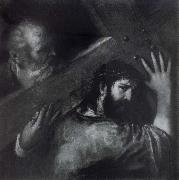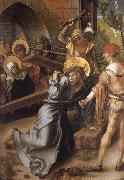Wholesale Oil Painting No Minimum |
|||||||||||
|
|
|||||||||||

|
|||||||||||
|
|
|
||||||||
TitianItalian High Renaissance Painter, ca.1485-1576 Italian painter active in Venice. As a young man he was taught by the Bellini family and worked closely with Giorgione. His early works are so similar in style to Giorgione's as to be indistinguishable, but soon after Giorgione's early death Titian established himself as the leading painter of the Republic of Venice. Among his most important religious paintings is the revolutionary and monumental Assumption (1516 ?C 18) for Santa Maria dei Frari, in which the Virgin ascends to heaven in a blaze of colour accompanied by a semicircle of angels. Titian was also interested in mythological themes, and his many depictions of Venus display his work's sheer beauty and inherent eroticism. Bacchus and Ariadne (1520 ?C 23), with its pagan abandon, is one of the greatest works of Renaissance art. Titian was sought after for his psychologically penetrating portraits, which include portrayals of leading Italian aristocrats, religious figures, and Emperor Charles V. He reached the height of his powers in The Rape of Europa (c. 1559 ?C 62), one of several paintings done for Philip II of Spain. He was recognized as supremely gifted in his lifetime, and his reputation has never declined. |
||||||||
|
|
||||||||
The Bearing of the Cross
The Bearing of the Cross Painting ID:: 40986 |
mk159
1560s
Oil on canvas
89.5x77cm
mk159 1560s Oil on canvas 89.5x77cm |
|||||||
|
|
||||||||
Albrecht Durerb.May 21, 1471, Imperial Free City of Nernberg [Germany] d.April 6, 1528, Nernberg Albrecht Durer (May 21, 1471 ?C April 6, 1528) was a German painter, printmaker and theorist from Nuremberg. His still-famous works include the Apocalypse woodcuts, Knight, Death, and the Devil (1513), Saint Jerome in his Study (1514) and Melencolia I (1514), which has been the subject of extensive analysis and interpretation. His watercolours mark him as one of the first European landscape artists, while his ambitious woodcuts revolutionized the potential of that medium. D??rer introduction of classical motifs into Northern art, through his knowledge of Italian artists and German humanists, have secured his reputation as one of the most important figures of the Northern Renaissance. This is reinforced by his theoretical treatise which involve principles of mathematics, perspective and ideal proportions. His prints established his reputation across Europe when he was still in his twenties, and he has been conventionally regarded as the greatest artist of the Renaissance in Northern Europe ever since. |
||||||||
|
|
||||||||
|
|
The Bearing of the Cross
The Bearing of the Cross Painting ID:: 42463 |
mk168
mk168 |
||||||
|
|
||||||||
Jacob JordaensFlemish Baroque Era Painter, 1593-1678 Jacob Jordeans was born on May 19, 1593, the first of eleven children, to the wealthy linen merchant Jacob Jordaens Sr. and Barbara van Wolschaten in Antwerp. Little is known about Jordaens's early education. It can be assumed that he received the advantages of the education usually provided for children of his social class. This assumption is supported by his clear handwriting, his competence in French and in his knowledge of mythology. Jordaens familiarity with biblical subjects is evident in his many religious paintings, and his personal interaction with the Bible was strengthened by his later conversion from Catholicism to Protestantism. Like Rubens, he studied under Adam van Noort, who was his only teacher. During this time Jordaens lived in Van Noort's house and became very close to the rest of the family. After eight years of training with Van Noort, he enrolled in the Guild of St. Luke as a "waterscilder", or watercolor artist. This medium was often used for preparing tapestry cartoons in the seventeenth century. although examples of his earliest watercolor works are no longer extant. In the same year as his entry into the guild, 1616, he married his teacher's eldest daughter, Anna Catharina van Noort, with whom he had three children. In 1618, Jordaens bought a house in Hoogstraat (the area in Antwerp that he grew up in). He would then later buy the adjoining house to expand his household and workspace in 1639, mimicking Rubens's house built two decades earlier. He lived and worked here until his death in 1678. Jordaens never made the traditional trip to Italy to study classical and Renaissance art. Despite this, he made many efforts to study prints or works of Italian masters available in northern Europe. For example, Jordaens is known to have studied Titian, Veronese, Caravaggio, and Bassano, either through prints, copies or originals (such as Caravaggio's Madonna of the Rosary). His work, however, betrays local traditions, especially the genre traditions of Pieter Bruegel the Elder, in honestly depicting Flemish life with authenticity and showing common people in the act of celebratory expressions of life. His commissions frequently came from wealthy local Flemish patrons and clergy, although later in his career he worked for courts and governments across Europe. Besides a large output of monumental oil paintings he was a prolific tapestry designer, a career that reflects his early training as a "watercolor" painter. Jordaens' importance can also be seen by his number of pupils; the Guild of St. Luke records fifteen official pupils from 1621 to 1667, but six others were recorded as pupils in court documents and not the Guild records, so it is probable that he had more students than officially recorded. Among them were his cousin and his son Jacob. Like Rubens and other artists at that time, Jordaens' studio relied on his assistants and pupils in the production of his paintings. Not many of these pupils went on to fame themselves,however a position in Jordaens's studio was highly desirable for young artists from across Europe. |
||||||||
|
|
||||||||
|
|
The Bearing of the Cross
The Bearing of the Cross Painting ID:: 89009 |
1657(1657)
Medium oil on canvas
Dimensions 239 x 174.5 cm (94.1 x 68.7 in)
cjr 1657(1657) Medium oil on canvas Dimensions 239 x 174.5 cm (94.1 x 68.7 in) cjr |
||||||
|
|
||||||||
|
Jacob Jordaens Flemish Baroque Era Painter, 1593-1678 Jacob Jordeans was born on May 19, 1593, the first of eleven children, to the wealthy linen merchant Jacob Jordaens Sr. and Barbara van Wolschaten in Antwerp. Little is known about Jordaens's early education. It can be assumed that he received the advantages of the education usually provided for children of his social class. This assumption is supported by his clear handwriting, his competence in French and in his knowledge of mythology. Jordaens familiarity with biblical subjects is evident in his many religious paintings, and his personal interaction with the Bible was strengthened by his later conversion from Catholicism to Protestantism. Like Rubens, he studied under Adam van Noort, who was his only teacher. During this time Jordaens lived in Van Noort's house and became very close to the rest of the family. After eight years of training with Van Noort, he enrolled in the Guild of St. Luke as a "waterscilder", or watercolor artist. This medium was often used for preparing tapestry cartoons in the seventeenth century. although examples of his earliest watercolor works are no longer extant. In the same year as his entry into the guild, 1616, he married his teacher's eldest daughter, Anna Catharina van Noort, with whom he had three children. In 1618, Jordaens bought a house in Hoogstraat (the area in Antwerp that he grew up in). He would then later buy the adjoining house to expand his household and workspace in 1639, mimicking Rubens's house built two decades earlier. He lived and worked here until his death in 1678. Jordaens never made the traditional trip to Italy to study classical and Renaissance art. Despite this, he made many efforts to study prints or works of Italian masters available in northern Europe. For example, Jordaens is known to have studied Titian, Veronese, Caravaggio, and Bassano, either through prints, copies or originals (such as Caravaggio's Madonna of the Rosary). His work, however, betrays local traditions, especially the genre traditions of Pieter Bruegel the Elder, in honestly depicting Flemish life with authenticity and showing common people in the act of celebratory expressions of life. His commissions frequently came from wealthy local Flemish patrons and clergy, although later in his career he worked for courts and governments across Europe. Besides a large output of monumental oil paintings he was a prolific tapestry designer, a career that reflects his early training as a "watercolor" painter. Jordaens' importance can also be seen by his number of pupils; the Guild of St. Luke records fifteen official pupils from 1621 to 1667, but six others were recorded as pupils in court documents and not the Guild records, so it is probable that he had more students than officially recorded. Among them were his cousin and his son Jacob. Like Rubens and other artists at that time, Jordaens' studio relied on his assistants and pupils in the production of his paintings. Not many of these pupils went on to fame themselves,however a position in Jordaens's studio was highly desirable for young artists from across Europe. The Bearing of the Cross 1657(1657) Medium oil on canvas Dimensions 239 x 174.5 cm (94.1 x 68.7 in) cjr |
||||||||
|
|
||||||||
|
Prev Next
|
||||||||
|
|
||||||||
|
Related Paintings to Jacob Jordaens :. |
||||||||
|
|
||||||||
|
CONTACT US |



